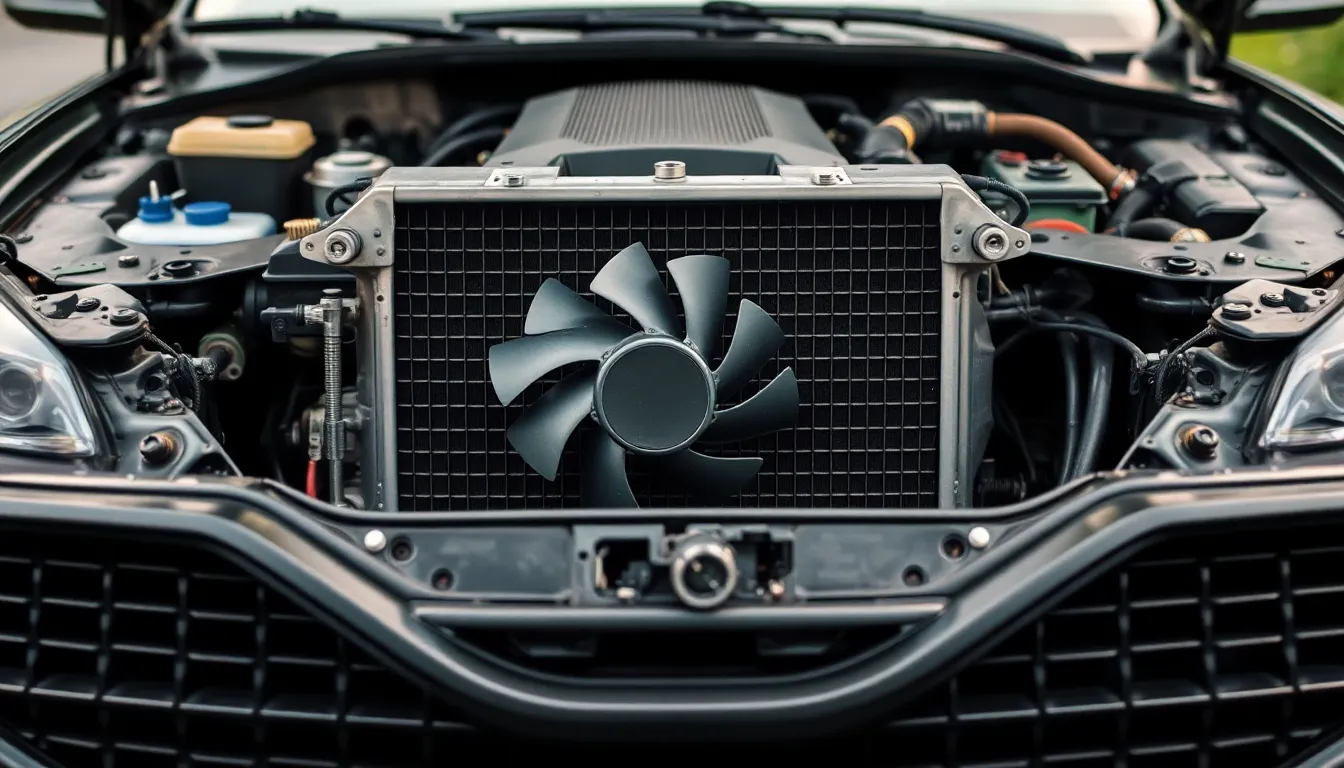The radiator plays a crucial role in a car’s cooling system, ensuring the engine runs efficiently and prevents overheating. For many drivers, understanding where this essential component is located can be a bit of a mystery. Knowing its position not only aids in basic car maintenance but also helps in troubleshooting potential issues.
Typically, the radiator is positioned at the front of the engine bay, just behind the grille. Its strategic placement allows it to draw in cool air while the vehicle is in motion. In this article, readers will discover more about the radiator’s location, its function, and why keeping it in good condition is vital for vehicle performance.
Table of Contents
ToggleUnderstanding the Radiator
The radiator is a critical component of a car’s cooling system. It plays a vital role in regulating engine temperature by dissipating heat generated during combustion. Typically located at the front of the engine bay, the radiator sits behind the grille. This positioning allows it to receive maximum airflow while the vehicle is in motion.
Radiators consist of a series of tubes and fins that enhance heat transfer. Coolant circulates through these tubes, absorbing heat from the engine. As the coolant flows through the radiator, external air passes over the fins, cools the liquid, and allows it to return to the engine at a lower temperature.
Understanding the radiator’s function underscores its importance in preventing engine overheating. Regular maintenance, including checking coolant levels and inspecting for leaks, ensures optimal performance. Overheating can lead to severe engine damage, resulting in costly repairs.
Inspecting the radiator also involves checking for debris or obstructions that could impede airflow. Keeping the area clear improves efficiency and prolongs the lifespan of the cooling system.
Locating the Radiator in a Car


Identifying the radiator’s location in a car is essential for effective maintenance and cooling system management. The radiator usually resides in the engine compartment, specifically positioned to maximize airflow during driving.
Common Locations
- Front of the Engine Bay: Most commonly, the radiator sits at the front of the engine bay, directly behind the grille. This positioning allows for optimal air intake.
- Beside the Engine: In some designs, the radiator may be located alongside the engine, enhancing space utilization within compact engine compartments.
- Near the Cooling Fan: The radiator often connects to the cooling fan, which activates to draw additional air through the radiator when temperatures rise.
Differences by Car Model
- Sedans and SUVs: Typically, sedans and SUVs feature a standard front-mounted radiator positioned behind the grille. This configuration offers straightforward access for maintenance.
- Sports Cars: In sports cars, radiators can be larger and often mounted lower to promote better aerodynamics and cooling efficiency.
- Electric Vehicles: Electric vehicles may incorporate different cooling systems, including radiators situated near battery packs to manage heat effectively.
Understanding the specific location and configuration of the radiator can aid in timely maintenance and help prevent overheating issues.
Importance of the Radiator
The radiator plays a vital role in ensuring a car’s engine operates within safe temperature limits. By effectively managing heat, it enhances engine performance and longevity.
Role in Engine Cooling
The radiator’s primary function involves dissipating excess heat from the engine. As coolant circulates through the engine, it absorbs heat and carries it to the radiator. Here, air passes through the tubes and fins, cooling the fluid before it re-enters the engine. Proper heat management prevents engine overheating, contributes to improved fuel efficiency, and supports overall vehicle performance.
Signs of Radiator Issues
Drivers should be aware of several signs indicating potential radiator problems. Common indicators include:
- Overheating: If the engine reaches high temperatures frequently, the radiator may not be functioning properly.
- Coolant Leaks: Puddles or stains under the vehicle can signal coolant leaks, often from the radiator itself.
- Reduced Coolant Levels: A drop in coolant levels without explanation suggests possible radiator issues.
- Cold Spots: If parts of the radiator feel cool while others do not, it may indicate a blockage or malfunction.
- Unusual Noises: Hissing or bubbling sounds can point to internal leaks or excessive pressure build-up.
Addressing these signs promptly ensures optimal radiator function and prevents severe engine damage.
Maintenance Tips for Your Radiator
- Check coolant levels regularly. Maintaining proper coolant levels ensures efficient heat dissipation. Low coolant levels can lead to overheating, so topping off coolant can prevent engine damage.
- Inspect for leaks. Looking for signs of leaks around the radiator and hoses. Detecting coolant puddles or stains can indicate a potential issue, which should be addressed promptly.
- Flush the radiator periodically. Flushing the radiator every two years removes rust and sediment buildup. This process enhances coolant flow and improves the system’s efficiency.
- Examine hoses and connections. Inspecting hoses for cracks or wear. Replacing damaged hoses maintains coolant circulation and prevents leaks.
- Keep the radiator clean. Removing dirt, debris, and insects from the radiator’s exterior. A clean radiator improves airflow and cooling efficiency.
- Monitor engine temperature. Paying attention to the temperature gauge on the dashboard. An overheating signal can indicate radiator issues, requiring immediate attention.
- Use the correct coolant type. Utilizing the manufacturer-recommended coolant type helps maintain optimal performance and reduces the risk of corrosion.
- Seek professional assistance when needed. Consulting a mechanic for radiator checks. Professional maintenance ensures any underlying issues receive proper attention.
Understanding the radiator’s location and function is essential for any car owner. By knowing where to find the radiator and how it operates within the cooling system, drivers can take proactive steps to ensure their vehicle runs smoothly. Regular checks and maintenance can prevent overheating and extend the engine’s life. Recognizing the signs of radiator issues early can save time and money on repairs. With this knowledge, car owners are better equipped to manage their vehicle’s health and performance effectively.




